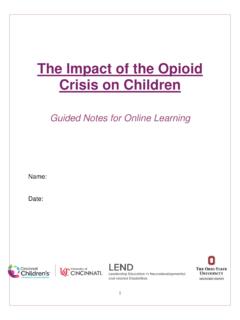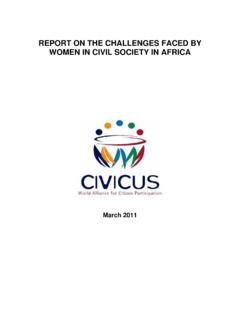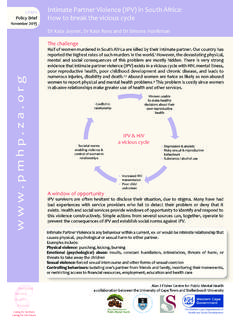Transcription of Distress migration and youth in protracted crises
1 GUIDANCE NOTE. Distress migration and youth in protracted crises The Junior Farmer Field and Life Schools approach Cover photo: FAO/Simon Maina The designations employed and the presentation of material in this information product do not imply the expression of any opinion whatsoever on the part of the Food and Agriculture Organization of the United Nations (FAO) concerning the legal or development status of any country, territory, city or area or of its authorities, or concerning the delimitation of its frontiers or boundaries. The mention of specific companies or products of manufacturers, whether or not these have been patented, does not imply that these have been endorsed or recommended by FAO in preference to others of a similar nature that are not mentioned. The views expressed in this information product are those of the author(s) and do not necessarily reflect the views or policies of FAO.
2 FAO encourages the use, reproduction and dissemination of material in this information product. Except where otherwise indicated, material may be copied, downloaded and printed for private study, research and teaching purposes, or for use in non-commercial products or services, provided that appropriate acknowledgement of FAO as the source and copyright holder is given and that FAO's endorsement of users' views, products or services is not implied in any way. All requests for translation and adaptation rights, and for resale and other commercial use rights should be made via or addressed to FAO information products are available on the FAO website ( ) and can be purchased through FAO, 2016. Contents Acknowledgments iii Key messages iv Distress migration and displacement of youth : key considerations 1. FAO multi-dimensional approach to migration 7.
3 Junior Farmer Field and Life Schools (JFFLS) 11. Remaining challenges and areas for further investigation 17. The way forward 19. References and resources for further information 21. This guidance note has been developed thanks to contributions from FAO staff across the Organization, under the leadership of the main authors: Francesca dalla Valle youth Employment and Institutional Partnerships Specialist, FAO and Laura Deotti Rural youth migration Specialist, FAO For information please contact: Peter Wobst Senior Programme Advisor, Strategic Programme on Rural Poverty Reduction, FAO. This document has been produced with the financial assistance of the European Union. The views expressed herein can in no way be taken to reflect the official opinion of the European Union. This guidance note is part of a series on improving food security and nutrition in protracted crises .
4 Drawing on FAO technical experience, the guidance notes series supports implementation of the Framework for Action for Food Security and Nutrition in protracted crises (CFS-FFA), endorsed by the Committee on World Food Security (CFS) in October 2015. The Junior Farmer Field and Life Schools approach iii uu migration is a common phenomenon in protracted crises , mainly resulting from displacement due to conflict, natural disasters and/or the deterioration of livelihoods. uu The challenges posed by migration are many: disruption of food and nutrition security, increasing competition among livelihood groups, ever greater numbers of displaced young people exposed to the threat of both violence and radicalization, plus a harmful impact on livelihoods in the countries of origin. uu However, migration also presents opportunities, including powerful drivers for sustainable post- conflict recovery, both for host communities and for young people seen as a dynamic force for rebuilding communities and peace.
5 Uu While addressing migration and the deterioration of livelihoods in protracted crises , policies and programmes should include specific interventions to promote viable employment and increased livelihood opportunities for youth . uu Rural development and food security are central to the global response to the migrant and refugee crisis. A multi-dimensional approach is crucial, addressing both the challenges and the root causes. FAO has adopted such an approach to resilience building. uu FAO Junior Farmer Field and Life Schools (JFFLS) methodology in various countries with protracted crises has proven effective in increasing the agricultural, business and life skills of young refugees, child soldiers and other vulnerable groups in protracted crises , thus helping them to become more resilient, productive and active members of their communities.
6 The methodology has also been used for peacebuilding and in Disarmament, Demobilization and Reintegration (DDR) programmes. uu A number of future measures must be adopted in programming, stabilization and early recovery efforts if the needs, rights and potential of the youth cohort are to be fully acknowledged and exploited. iv GUIDANCE NOTE. Distress migration and displacement of youth : key considerations migration is increasing and is a common trend in crisis situations migration , both international and internal, has increased steadily over the years, becoming an established feature of the global social and economic landscape for many young people. Every year, millions are forced to flee from war, poverty and other hardships a tragic reminder of the urgent need for peaceful solutions based on social justice and improved economic opportunities for all.
7 In 2015, there were 244. million international migrants, with an increase of 41 percent compared to 2 000 (United Nations, 2015). The international community is also facing a challenging situation with a range of complex population displacement contexts. These include acute and protracted crises and the ongoing impacts of major humanitarian emergencies. By the end of 2016 some 56 million people will be trapped in a state of protracted displacement at significant risk of violence and exploitation, typically unable to work or access basic social services (IOM, 2016). What do we mean by youth '? The FAO acknowledges the UN definition and generally follows the general youth age frame of 15-24. It contributes to international analysis of that group, particularly in rural contexts. For activities at regional or national level, where youth may be understood in a more flexible manner, the FAO adopts the definition of youth as used by a particular Member State while also recognizing that within the various definitions different approaches should be adopted.
8 This is particularly true in specific protracted and post-conflict contexts where the years of 'childhood''. and ' youth '' may frequently be lost. There is a deliberate overlap in the definitions of child' (under 18) and youth ' (15 to 17). As per the Geneva Convention on the Rights of the Child, any individual below the age of 18 has legal framework protection in the terms described by the convention itself in the signatory countries. The Junior Farmer Field and Life Schools approach 1. About a third of the migrant flow from developing countries is aged between 12 and 24, and half from the 12 to 29 bracket. Young women account for approximately half of youth migrant population (World Bank, 2006). Fifty percent of the billion people living in countries impacted by crises and fragility are under the age of 20 (United Nations, 2016).
9 Young migrants constitute a diverse group. Their social, economic and educational backgrounds, the means/forms of migration , and their motivation for leaving all influence the scope, scale and type of migration . Typologies of migration and migrants The term migrant' is defined by the International Organization for migration (IOM) as any person who is moving or has moved across an international border or within a State away from his/her habitual place of residence, regardless of (1) the person's legal status; (2) whether the movement is voluntary or involuntary; (3) what the causes for the movement are; or (4) what the length of the stay is'. migration is therefore the movement of a person or a group of persons, either across an international border, or within a state. This may encompass any kind of movement of people, whatever its length, composition and causes, including the migration of refugees, displaced persons, economic migrants, and persons moving for other purposes, and family reunification (IOM, 2011).
10 However, there is no universal categorization of migrants, as each country has its own policies, legislation and statistics regarding migration . Nevertheless, this concept can be further categorized as follows: Distress migration : Movements from the usual place of residence, undertaken when the individual and/or the family perceive that there are no options open to them to survive with dignity, except to migrate. Distress ' migration is motivated by extreme economic deprivation, natural and environmental disasters, or forms of gender and social oppression perceived to be intolerable (Mander and Sahgal, 2012). Internal migration : Movement of people from one area of a country to another area of the same country including: (i) rural to urban migration ; (ii) rural to rural migration ( seasonal migration linked to agricultural calendars); (iii) urban to rural migration ; and, (iv) urban to urban migration (IOM, 2011).
















